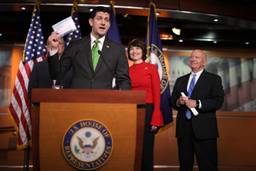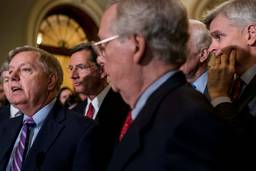Trump Talks a Big Infrastructure Game But His Budget Tells a Different Story
Josh Bivens and Hunter Blair

This article was first posted by the Economic Policy Institute.
It has been declared “infrastructure week” by the Trump administration. On the face of it, that should be excellent news. The U.S. economy would benefit enormously from an ambitious increase in public investment, including infrastructure investment. Such investment would create jobs and finally lock-in genuine full employment in the near-term, and would provide a needed boost to productivity growth (or how much income and output each hour of work generates in the economy) in the medium-term. Further, infrastructure investments would ensure that we do not leave future generations a deficit of underinvestment and deferred maintenance of public assets.
This clear need is why we at EPI have been such enthusiastic backers of the Congressional Progressive Caucus (CPC) plan to boost infrastructure investment. The CPC investment plan is up to the scale of the problem, and it confronts the need to make these investments head-on, without accounting gimmicks or magical thinking about where the money for these investments will come from.
Despite being long-standing and loud proponents of the need for more infrastructure investment, however, we cannot say we expect much from the Trump administration’s infrastructure week. Why not? Because the most common theme in the Trump administration’s approach to infrastructure is pure obfuscation about how it will be paid for. If you’re not willing to say forthrightly how you’re going to pay for infrastructure investments, you really cannot be serious about it. As the old adage goes, “show me your budget and I’ll tell you what you value”.
The recently released Trump federal budget plan guts infrastructure, period. Read the link — the damage the Trump budget would do to public investment and infrastructure is staggering. This alone should make any open-minded person extraordinarily skeptical of their claims to value infrastructure spending.
The Trump campaign plan on infrastructure was notable only for its shallowness and its determination to increase cronyism in infrastructure provision. The plan claimed that the problem with American infrastructure investment was a lack of innovative financing, and that the private sector could somehow be convinced to build infrastructure at no cost to taxpayers. This was obviously false. Even long-standing, bipartisan efforts to leverage private sector financing of infrastructure have ranged from disappointing to disastrous. And in no case did they provide a free lunch to taxpayers — unless taxpayers have a huge preference to paying tolls to private companies rather than the same amount of tolls or taxes to governments.
The problem holding back increased investment in American infrastructure is simple: politicians are simply unwilling to increase public spending in a transparent way. This must be overcome — America needs a significant investment in public assets, and it needs this investment to be transparent, subject to democratic accountability, and long-lived.
The sketch of the new Trump infrastructure effort included in their budget shows clearly that they do not get this. Instead, the plan is more obfuscation and magical thinking. They claim their plan will lead to $1 trillion in new investments. Yet only $200 billion in new federal spending is specified (and again, this must be balanced against the enormous cuts to public investment already embedded in their overall budget plan). Where does the rest of the funding come from? In a word, nowhere. There is hand waving about leveraging the private sector and vague claims that federal “divestment” from infrastructure provision will somehow empower state and local governments to do more (but without any new funding source for these governments!). But like Trump’s campaign plan, this is an unserious document meant to sound like an infrastructure investment plan, but one that would radically underinvest in projects overall, and which would prioritize projects that can provide profits to private entities (like toll roads to airports) rather than projects that provide the largest welfare boost to vulnerable communities (say replacing lead-laced water pipes for communities like Flint, Michigan).
National Economic Council Director Gary Cohn summed up the Trump approach well: “We like the template of not using taxpayer dollars to give taxpayers wins.” Who wouldn’t? And there are legitimate ways to give taxpayers wins without using taxpayer money. Raise the federal minimum wage, for example. Or restore workers’ rights to bargain collectively. Or pursue genuine full employment. But if you’re trying to spend money on public assets, the idea that this can be done while “not using taxpayer dollars” is a pure dodge.
Infrastructure investment should be taken seriously. The stakes are large: each $1 billion in such investment has the potential to support more than 18,000 jobs—and these jobs are disproportionately well-paying (so long as no strings are attached to the investments that spurred them —like the erosion of workers protections). And as private sector investment has lagged in the aftermath of the Great Recession, the most obvious path to boosting productivity growth is through an increase in public investments. An optimal plan would pair infrastructure investments in the nation’s physical capital stock with a big increase in public investment in human capital, with early childcare and education being an obvious place to earn big returns.
But because the stakes are so large, we should not let policymakers get credit for fake plans. The Trump administration’s rhetoric on infrastructure is loud and real. The administration’s plans are thin and fake.

I hope you found this article important. Before you leave, I want to ask you to consider supporting our work with a donation. In These Times needs readers like you to help sustain our mission. We don’t depend on—or want—corporate advertising or deep-pocketed billionaires to fund our journalism. We’re supported by you, the reader, so we can focus on covering the issues that matter most to the progressive movement without fear or compromise.
Our work isn’t hidden behind a paywall because of people like you who support our journalism. We want to keep it that way. If you value the work we do and the movements we cover, please consider donating to In These Times.





